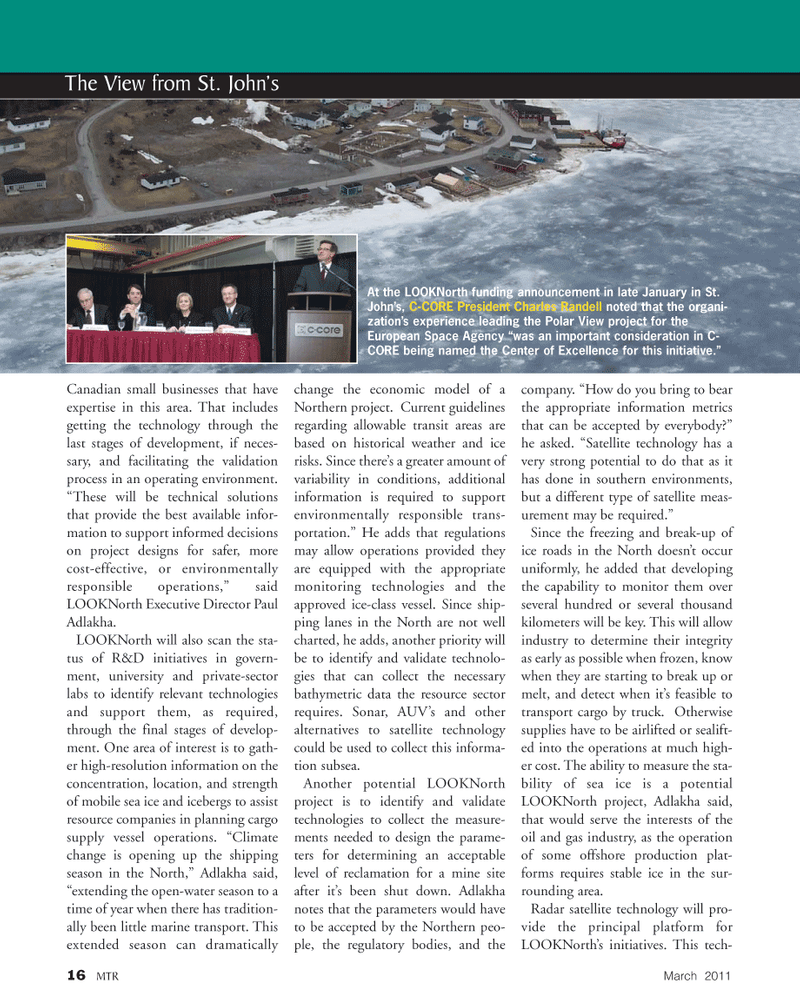
Page 16: of Marine Technology Magazine (March 2011)
Subsea Vehicles: AUV, ROV, UUV Annual
Read this page in Pdf, Flash or Html5 edition of March 2011 Marine Technology Magazine
The View from St. John’s
Canadian small businesses that have expertise in this area. That includes getting the technology through the last stages of development, if neces- sary, and facilitating the validation process in an operating environment. “These will be technical solutions that provide the best available infor- mation to support informed decisions on project designs for safer, more cost-effective, or environmentally responsible operations,” said
LOOKNorth Executive Director Paul
Adlakha.
LOOKNorth will also scan the sta- tus of R&D initiatives in govern- ment, university and private-sector labs to identify relevant technologies and support them, as required, through the final stages of develop- ment. One area of interest is to gath- er high-resolution information on the concentration, location, and strength of mobile sea ice and icebergs to assist resource companies in planning cargo supply vessel operations. “Climate change is opening up the shipping season in the North,” Adlakha said, “extending the open-water season to a time of year when there has tradition- ally been little marine transport. This extended season can dramatically change the economic model of a
Northern project. Current guidelines regarding allowable transit areas are based on historical weather and ice risks. Since there’s a greater amount of variability in conditions, additional information is required to support environmentally responsible trans- portation.” He adds that regulations may allow operations provided they are equipped with the appropriate monitoring technologies and the approved ice-class vessel. Since ship- ping lanes in the North are not well charted, he adds, another priority will be to identify and validate technolo- gies that can collect the necessary bathymetric data the resource sector requires. Sonar, AUV’s and other alternatives to satellite technology could be used to collect this informa- tion subsea.
Another potential LOOKNorth project is to identify and validate technologies to collect the measure- ments needed to design the parame- ters for determining an acceptable level of reclamation for a mine site after it’s been shut down. Adlakha notes that the parameters would have to be accepted by the Northern peo- ple, the regulatory bodies, and the company. “How do you bring to bear the appropriate information metrics that can be accepted by everybody?” he asked. “Satellite technology has a very strong potential to do that as it has done in southern environments, but a different type of satellite meas- urement may be required.”
Since the freezing and break-up of ice roads in the North doesn’t occur uniformly, he added that developing the capability to monitor them over several hundred or several thousand kilometers will be key. This will allow industry to determine their integrity as early as possible when frozen, know when they are starting to break up or melt, and detect when it’s feasible to transport cargo by truck. Otherwise supplies have to be airlifted or sealift- ed into the operations at much high- er cost. The ability to measure the sta- bility of sea ice is a potential
LOOKNorth project, Adlakha said, that would serve the interests of the oil and gas industry, as the operation of some offshore production plat- forms requires stable ice in the sur- rounding area.
Radar satellite technology will pro- vide the principal platform for
LOOKNorth’s initiatives. This tech- 16 MTR March 2011
At the LOOKNorth funding announcement in late January in St.
John’s, C-CORE President Charles Randell noted that the organi- zation’s experience leading the Polar View project for the
European Space Agency “was an important consideration in C-
CORE being named the Center of Excellence for this initiative.”

 15
15

 17
17
